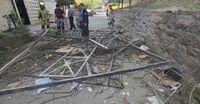On Thursday morning, a powerful explosion ripped through a laboratory at the University of Tehran, leaving the academic community in shock and mourning. The blast, which occurred at the Faculty of Metallurgy and Materials Engineering located on the university’s technical campus in Amirabad, resulted in the death of one student and left at least two others severely injured, according to multiple reports from Iranian media and university officials.
The incident unfolded around 9 a.m. local time, just as the day’s academic activities were getting underway. According to a deputy who spoke to Iranian media, the explosion was triggered by a hydrogen cylinder inside the materials and metallurgy laboratory. The resulting force was so intense that it collapsed walls, shattered windows, and left a section of the lab reduced to rubble—a scene described by university authorities as devastating and chaotic.
While initial reports varied slightly in the number of injured—some stating that four people were hurt, others confirming that at least two were severely wounded—it is clear that the toll was significant. University officials have not yet released the names of the victims, citing ongoing investigations and the need to notify families. The identity of the deceased student remains confidential as authorities work through the aftermath.
Eyewitnesses and first responders described a scene marked by confusion and urgency. Emergency services rushed to the site, navigating debris and unstable structures to evacuate the injured and secure the area. The swift response likely prevented further casualties, though the psychological impact on students and staff is likely to linger for some time.
According to APA, the exact cause of the explosion remains undetermined. While officials have identified the hydrogen cylinder as the source, questions persist about what led to its failure. Was it a technical malfunction, human error, or perhaps an overlooked safety protocol? As of Friday afternoon, university authorities confirmed that a formal investigation is underway to determine the precise chain of events that culminated in this tragedy.
The blast not only caused loss of life and injuries but also inflicted substantial damage on the laboratory itself. The force of the explosion was strong enough to collapse interior walls and send glass flying across the facility, leaving the area in ruins. The affected section of the lab will require extensive repairs before it can be deemed safe for use again, and the university has announced that all activities in the building have been temporarily suspended pending the outcome of the investigation.
This incident is particularly jarring for the University of Tehran, one of Iran’s most prestigious academic institutions, known for its rigorous scientific programs and advanced research facilities. The Faculty of Metallurgy and Materials Engineering, in particular, is a hub for innovation and experimentation—factors that, while vital for progress, also carry inherent risks when dealing with volatile substances like hydrogen.
The explosion at the University of Tehran was not an isolated event in the country’s academic sector this week. As reported by Iranian media, the tragedy came just a day after another deadly accident involving university students in Semnan province. While details about the Semnan incident remain sparse, the proximity of these two events has raised concerns about laboratory safety standards across Iranian universities.
University officials have responded with solemnity and resolve. In a statement to the press, a deputy from the technical campus emphasized the institution’s commitment to uncovering the truth behind the explosion and to supporting those affected. “We are deeply saddened by this loss and are doing everything in our power to assist the injured and their families,” the official stated, underscoring the gravity of the situation and the university’s sense of responsibility.
For many students and faculty members, the incident has sparked renewed anxiety about safety protocols in university laboratories. While accidents involving hazardous materials are not unheard of in research settings, the scale and severity of Thursday’s explosion have prompted calls for immediate review and reinforcement of safety measures. Some have questioned whether routine inspections and staff training are sufficient to prevent such disasters, especially when working with highly flammable gases like hydrogen.
The broader academic community in Tehran and beyond is watching closely as the investigation unfolds. Experts in laboratory safety have weighed in, noting that hydrogen, while commonly used in materials science and engineering experiments, requires meticulous handling and robust containment systems. Even a small leak or lapse in procedure can have catastrophic consequences, as this week’s events have so starkly demonstrated.
Beyond the technical aspects, the human cost of the explosion is at the forefront of many minds. The loss of a young life, the injuries sustained by others, and the trauma experienced by those who witnessed the incident have cast a pall over the university. Counseling services have been made available to students and staff, and community leaders have called for solidarity and support as the campus begins the difficult process of recovery.
Meanwhile, authorities have pledged transparency in their investigation. “An investigation into the case is underway,” APA reported, echoing the commitment of university and governmental officials to identify the root cause of the explosion and to implement necessary reforms. The hope is that lessons learned from this tragedy will lead to improved safety standards and prevent similar incidents in the future.
As the University of Tehran grapples with the aftermath, the incident serves as a stark reminder of the risks inherent in scientific research and the paramount importance of safety in academic environments. The coming weeks will likely bring further details as investigators piece together what happened and why. For now, the university community—and the nation at large—mourns the loss and looks to the future with a renewed commitment to vigilance and care.
While the investigation continues and repairs begin, the resilience of the University of Tehran’s faculty, students, and staff will be tested. But if history is any guide, this storied institution will emerge from the tragedy stronger and more determined than ever to balance the pursuit of knowledge with the imperative of safety.

